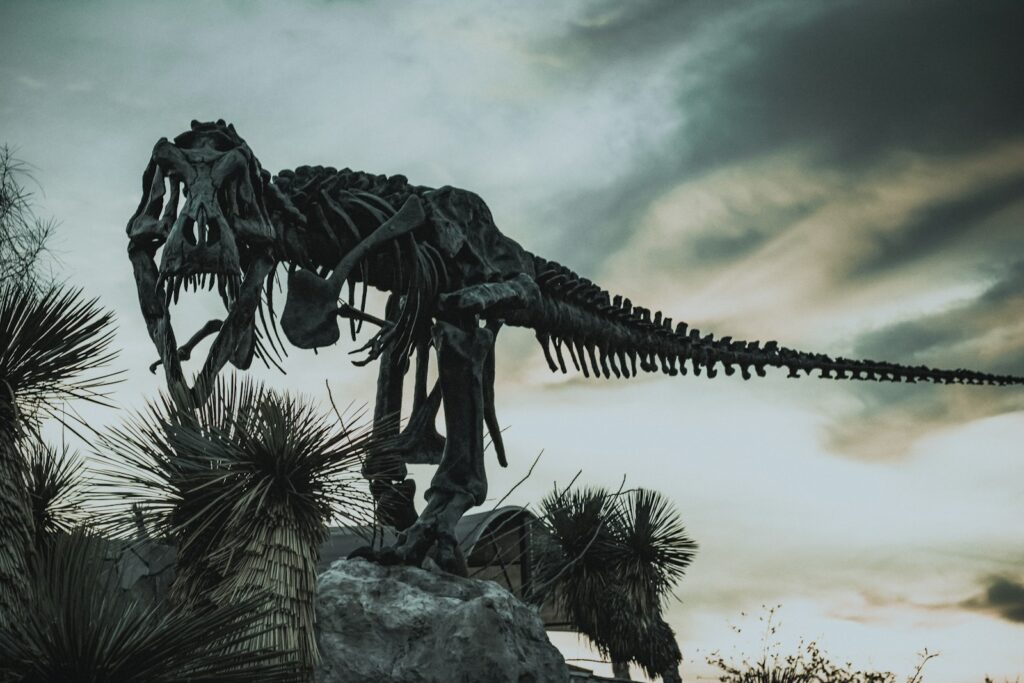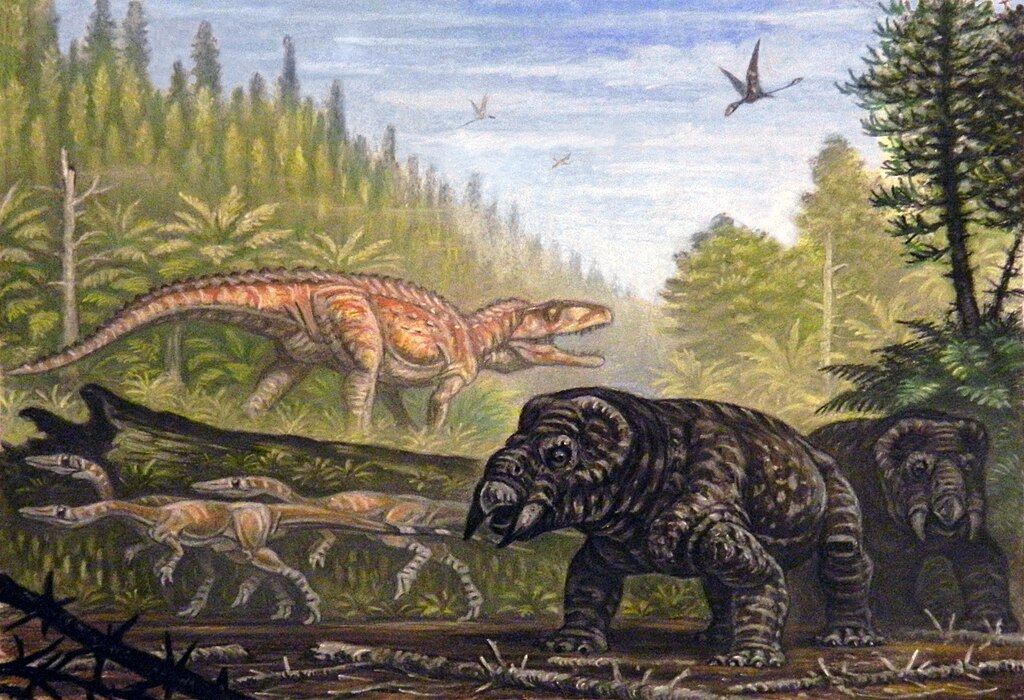Picture this: a world where colossal beasts roamed steamy jungles, where the air was thick with moisture and the ground shook under massive feet. Then, in what seems like the blink of an eye in geological terms, ice caps form, temperatures plummet, and these giants face their greatest enemy—not meteors or predators, but the very climate that once nurtured them. This wasn’t just a one-time event that happened at the end of the Cretaceous period. Climate change was the ultimate game-changer for dinosaurs, reshaping their world multiple times across their 165-million-year reign.
The Triassic Furnace That Forged the First Giants
The Late Triassic period wasn’t just hot—it was a planetary furnace that would make today’s climate concerns seem mild by comparison. With atmospheric carbon dioxide levels reaching nearly 2,000 parts per million (compared to today’s 420 ppm), Earth experienced a greenhouse effect so intense that polar ice caps simply couldn’t exist. This scorching world created the perfect laboratory for dinosaur evolution.
During this period, the first true dinosaurs emerged from their archosaur ancestors, taking advantage of the warm, humid conditions that supported lush vegetation across most continents. Species like Eoraptor and Herrerasaurus thrived in these tropical conditions, their small but efficient bodies perfectly adapted to the consistently warm temperatures. The absence of seasonal variation meant these early dinosaurs could remain active year-round, giving them a crucial advantage over their cold-blooded competitors.
When Volcanic Winters Nearly Ended Everything
The Triassic-Jurassic extinction event, occurring around 201 million years ago, demonstrates just how dramatically climate could reshape the dinosaur world. Massive volcanic eruptions from the Central Atlantic Magmatic Province pumped enormous quantities of sulfur dioxide and ash into the atmosphere, creating a “volcanic winter” that blocked sunlight for years. Temperatures plummeted by as much as 10 degrees Celsius globally, turning the once-balmy world into a frozen wasteland.
This climate catastrophe eliminated roughly 80% of all species, including many early dinosaur competitors like large pseudosuchians and various synapsids. However, some dinosaur lineages survived this brutal filter, emerging from the extinction event positioned to dominate the new world. Their survival wasn’t just luck—it was likely due to their developing warm-blooded characteristics and smaller body sizes that required less energy to maintain during the harsh conditions.
The Jurassic Greenhouse Paradise
Following the Triassic-Jurassic extinction, Earth rebounded into one of the most stable and warm periods in its history. The Early to Middle Jurassic saw global temperatures rise again, creating a greenhouse world with sea levels nearly 200 meters higher than today. This climate stability lasted for roughly 50 million years, providing dinosaurs with their longest period of uninterrupted evolutionary development.
The consistently warm and humid conditions during this period allowed dinosaurs to grow to unprecedented sizes. Sauropods like Brachiosaurus and Diplodocus evolved their massive bodies partly because the stable climate meant they could count on year-round food availability. The absence of polar ice caps meant that vegetation could grow at high latitudes, creating vast forests that could support these gentle giants across nearly every continent.
Seasonal Shifts and the Rise of Feathered Dinosaurs
As the Jurassic period progressed into the Cretaceous, subtle but significant climate changes began to reshape dinosaur evolution once again. The previously stable greenhouse conditions started to develop more pronounced seasonal variations, particularly in higher latitudes. This shift toward more variable temperatures created new evolutionary pressures that would fundamentally change how dinosaurs looked and behaved.
The development of feathers in many dinosaur lineages wasn’t initially about flight—it was about thermoregulation in an increasingly variable climate. Species like Sinosauropteryx and Yutyrannus developed primitive feathers to help regulate their body temperature during cooler periods. These adaptations proved so successful that they spread throughout many theropod lineages, eventually leading to the evolution of birds.
The Great Cretaceous Cooling Crisis
Around 120 million years ago, during the Aptian-Albian period, Earth experienced one of the most dramatic climate shifts of the Mesozoic era. Global temperatures dropped by approximately 5-7 degrees Celsius over just a few million years, creating the first significant cooling event since the Triassic-Jurassic extinction. This period, known as the “Cretaceous cooling,” fundamentally altered ecosystems worldwide and forced dinosaurs to adapt or perish.
The cooling event led to the formation of the first polar ice caps in over 100 million years, dramatically lowering sea levels and creating entirely new continental configurations. Dinosaur populations that had spread across warm, connected landmasses suddenly found themselves isolated on separate continents with distinctly different climates. This geographic isolation, combined with the temperature drop, accelerated dinosaur evolution and led to the development of many regionally distinct species.
Ice Age Dinosaurs: The Polar Pioneers
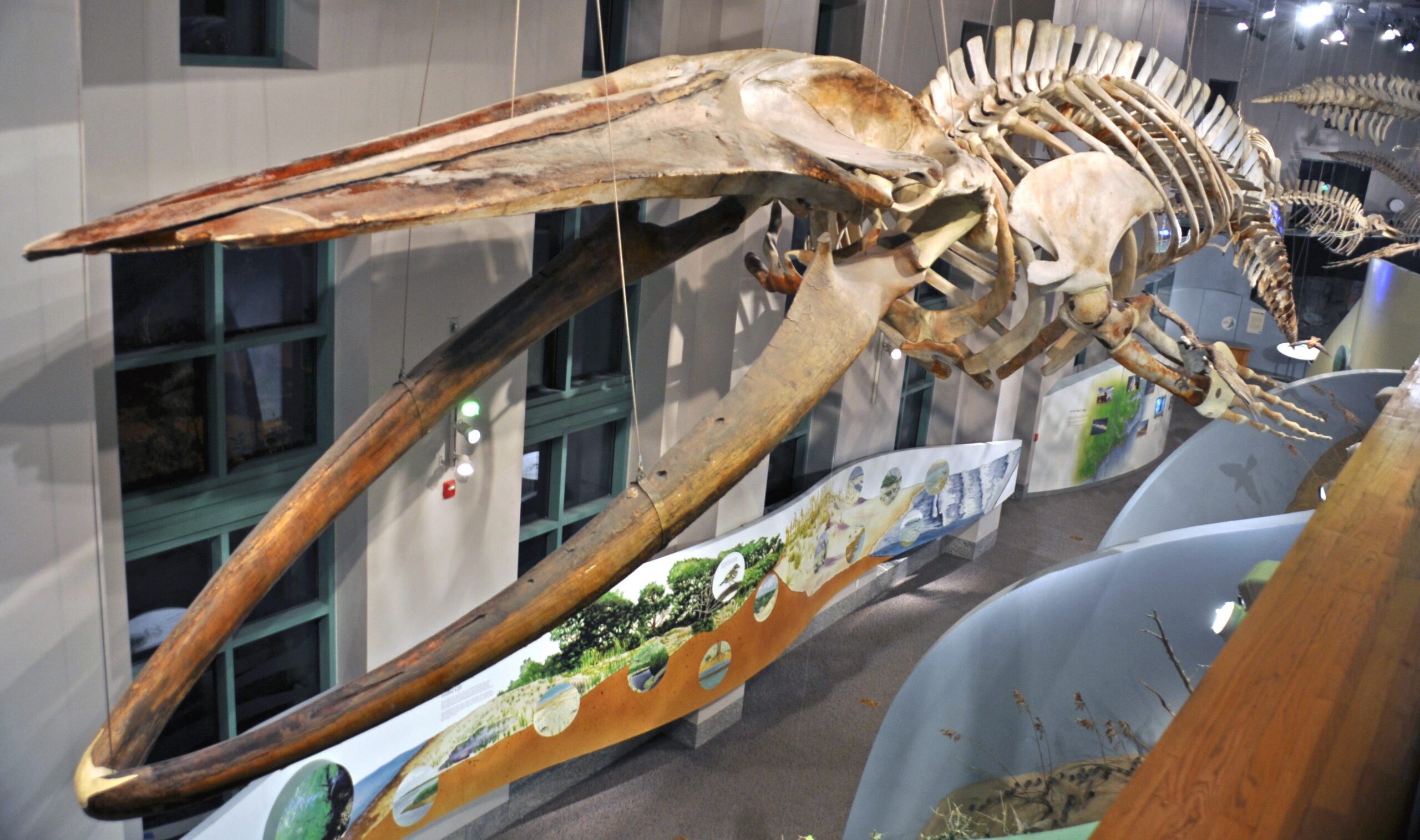
One of the most remarkable discoveries in paleontology has been the evidence of dinosaurs living in polar regions during cold periods. In Alaska and Australia, paleontologists have uncovered fossils of dinosaurs that lived at latitudes exceeding 70 degrees, where they would have experienced months of complete darkness during winter. These “polar dinosaurs” developed extraordinary adaptations to survive in conditions that would challenge even modern Arctic animals.
Species like Leaellynasaura from Australia had enlarged eye sockets, suggesting enhanced vision for navigating long polar nights. Meanwhile, Alaskan dinosaurs like Ugrunaaluk showed evidence of rapid growth patterns, allowing them to reach maturity quickly during brief Arctic summers. These adaptations demonstrate that dinosaurs weren’t just tropical creatures—they were remarkably adaptable animals capable of thriving in diverse climatic conditions.
The Cretaceous Thermal Maximum Explosion
The middle Cretaceous period, particularly around 90-100 million years ago, witnessed what scientists call the Cretaceous Thermal Maximum—perhaps the hottest period in Earth’s history. Global temperatures soared to levels that would have made the equator uninhabitable for most modern life forms, with even the poles experiencing subtropical conditions. This extreme greenhouse world created opportunities for dinosaur diversification on an unprecedented scale.
During this scorching period, dinosaurs reached their peak diversity, with new species evolving rapidly to fill ecological niches in the expanded tropical zones. The extreme warmth allowed cold-blooded reptiles to grow to enormous sizes, while warm-blooded dinosaurs could maintain active lifestyles in regions that were previously too cold. This thermal maximum period saw the evolution of some of the largest land animals ever to exist, including massive sauropods and the fearsome Carcharodontosaurus.
Volcanic Chaos and Dinosaur Resilience
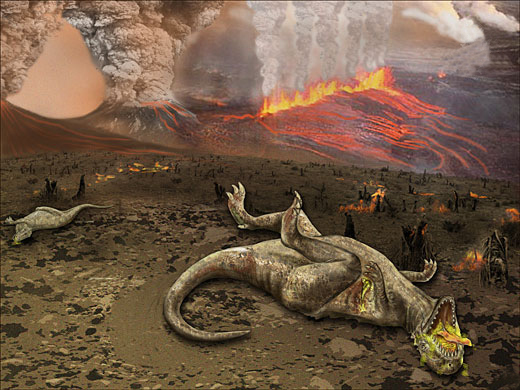
Throughout the Cretaceous period, massive volcanic events repeatedly tested dinosaur resilience. The formation of Large Igneous Provinces, such as the Ontong Java Plateau and the Kerguelen Plateau, released enormous quantities of greenhouse gases and toxic compounds into the atmosphere. These volcanic events created rapid climate swings that would have devastated less adaptable life forms.
Remarkably, dinosaurs not only survived these volcanic episodes but often emerged more diverse than before. The Cenomanian-Turonian extinction event, caused by massive volcanism around 94 million years ago, eliminated many marine species but had relatively little impact on terrestrial dinosaur populations. This resilience suggests that dinosaurs had developed sophisticated physiological and behavioral adaptations that allowed them to weather even the most extreme climate fluctuations.
The Deccan Traps: A Slow-Motion Apocalypse
Long before the famous asteroid impact, dinosaurs were already facing their greatest climate challenge yet. The Deccan Traps volcanism in what is now India began around 66.5 million years ago, releasing massive amounts of sulfur dioxide, carbon dioxide, and toxic metals into the atmosphere over a period of nearly a million years. This prolonged volcanic activity created a slow-motion climate catastrophe that gradually weakened dinosaur ecosystems.
The Deccan volcanism caused dramatic temperature swings, with initial cooling from sulfur aerosols followed by intense warming from carbon dioxide buildup. These wild climate fluctuations made it increasingly difficult for large dinosaurs to maintain stable populations, as their food sources became unreliable and their habitats fragmented. Many paleontologists now believe that this volcanic climate change was already driving dinosaur decline before the asteroid delivered the final blow.
Migration Patterns in a Changing World
As climates shifted throughout the Mesozoic era, dinosaurs developed sophisticated migration strategies to track suitable habitats. Fossil evidence from various continents shows that many dinosaur species followed predictable seasonal migration routes, moving between breeding and feeding grounds as temperatures and food availability changed. These migrations often spanned hundreds or even thousands of kilometers, rivaling the great migrations of modern mammals.
Trackway evidence from the Morrison Formation and other sites reveals that sauropods in particular were highly mobile, following river systems and vegetation patterns across vast distances. These migrations weren’t just seasonal movements—they were long-term adaptations to climate change, allowing dinosaur populations to persist even as their traditional habitats became unsuitable. The ability to migrate effectively may have been one of the key factors that allowed dinosaurs to survive multiple climate crises throughout their evolutionary history.
Atmospheric Chemistry and Dinosaur Metabolism
The changing composition of Earth’s atmosphere during the Mesozoic era had profound effects on dinosaur physiology and behavior. Oxygen levels fluctuated dramatically, from around 15% during the Triassic to nearly 35% during the Cretaceous, compared to today’s 21%. These changes in atmospheric chemistry directly influenced how dinosaurs could grow, breathe, and maintain their body temperature.
During periods of high oxygen concentration, dinosaurs could support more active metabolisms and grow to larger sizes with less effort. The elevated oxygen levels also may have contributed to the evolution of more efficient respiratory systems, including the sophisticated air sac systems that modern birds inherited from their dinosaur ancestors. Conversely, periods of low oxygen forced dinosaurs to develop more efficient cardiovascular systems and may have contributed to the evolution of warm-blooded metabolism in some lineages.
Ocean Currents and Continental Drift Effects
The gradual breakup of Pangaea during the Mesozoic era fundamentally altered global ocean currents and, consequently, climate patterns worldwide. As continents drifted apart, new ocean basins formed and existing ones changed shape, dramatically altering heat distribution across the planet. These changes created entirely new climate zones and eliminated others, forcing dinosaurs to adapt to rapidly changing environmental conditions.
The opening of the Atlantic Ocean, for example, created new warm water currents that brought tropical conditions to previously temperate regions. Similarly, the separation of Antarctica from other continents eventually led to the formation of the Antarctic Circumpolar Current, which would later contribute to global cooling. Dinosaurs living on these drifting continents had to adapt not only to changing geography but also to the new climate patterns that emerged as their landmasses moved to different latitudes.
Forest Fires and Ecosystem Disruption
Climate change during the Mesozoic era often manifested through increased wildfire activity, which had cascading effects on dinosaur populations. Charcoal deposits from various periods show that forest fires were becoming more frequent and intense as atmospheric conditions changed. These fires didn’t just destroy habitat—they fundamentally altered the structure of ecosystems and forced dinosaurs to develop new survival strategies.
Some dinosaur species adapted to fire-prone environments by developing behaviors similar to modern animals in fire-adapted ecosystems. Evidence suggests that certain theropods may have learned to take advantage of post-fire conditions, hunting prey that was fleeing burning areas or feeding on animals killed by smoke inhalation. Meanwhile, herbivorous dinosaurs had to adapt to rapidly changing vegetation patterns as fires repeatedly reset plant communities across their ranges.
The Final Climate Countdown
The final few million years of the Cretaceous period saw increasingly unstable climate conditions that set the stage for the dinosaurs’ ultimate demise. Even without the asteroid impact, the combination of Deccan volcanism, changing ocean chemistry, and shifting atmospheric composition was creating a perfect storm of environmental stress. Temperature fluctuations became more extreme, sea levels dropped dramatically, and ecosystems became increasingly fragmented.
Dinosaur diversity was already declining in many regions as these climate pressures mounted. The massive forms that had dominated the middle Cretaceous were giving way to smaller, more adaptable species that could better cope with resource scarcity and habitat instability. This suggests that dinosaurs were already in the process of major evolutionary transitions when the asteroid impact occurred, potentially accelerating changes that were already underway due to climate pressures.
Legacy of Climate Adaptation
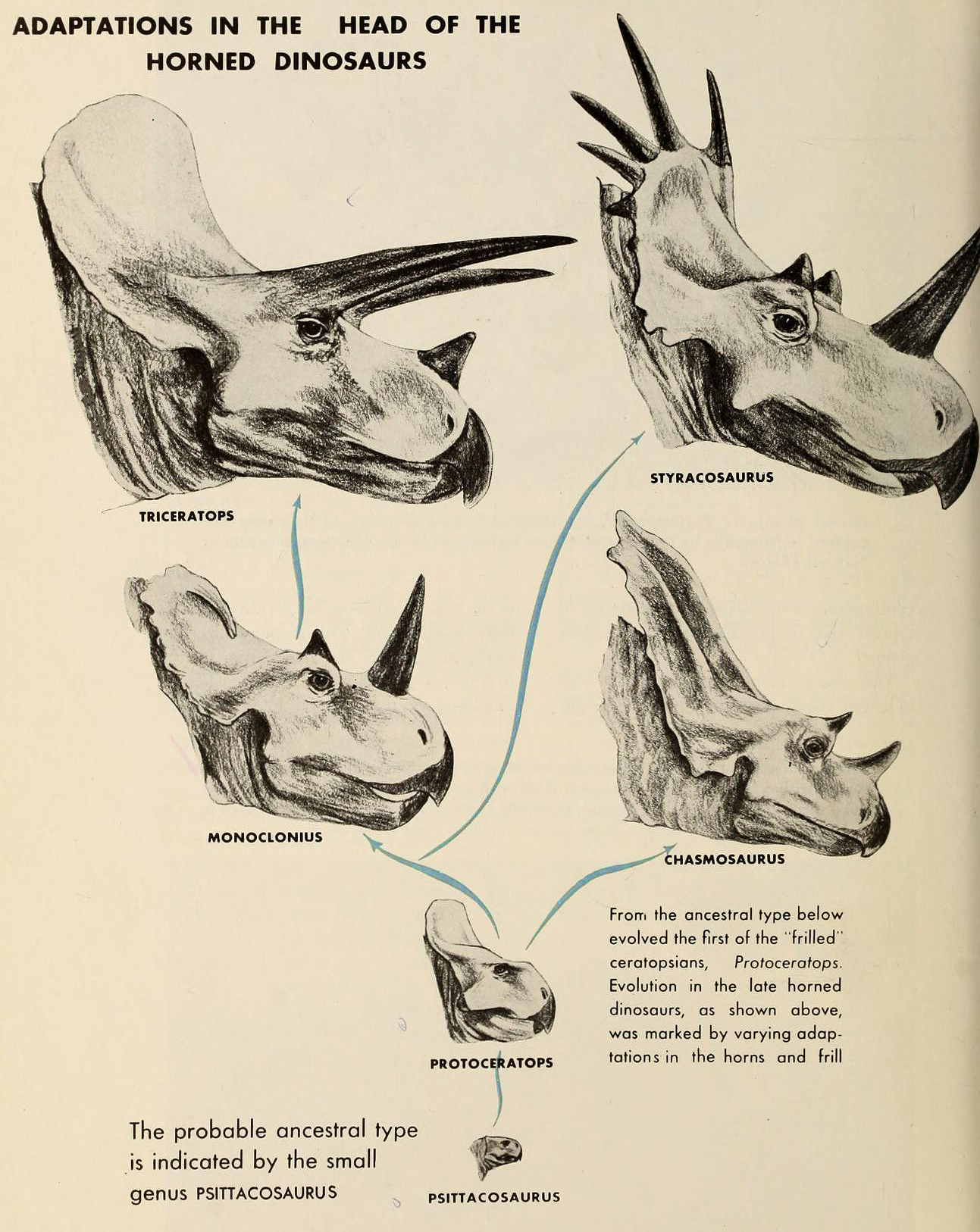
The story of dinosaurs and climate change isn’t just about extinction—it’s about extraordinary adaptation and resilience in the face of environmental challenges that would have overwhelmed less flexible life forms. Over their 165-million-year history, dinosaurs survived multiple mass extinctions, ice ages, greenhouse periods, and volcanic catastrophes by continuously evolving new strategies for dealing with changing conditions.
The survivors of this evolutionary gauntlet—modern birds—carry within their genes the accumulated wisdom of millions of years of climate adaptation. Their sophisticated respiratory systems, efficient metabolisms, and behavioral flexibility all trace back to adaptations that helped their dinosaur ancestors survive in an ever-changing world. In our current era of rapid climate change, we might do well to study these ancient masters of adaptation.
The reign of the dinosaurs wasn’t just a story of domination—it was a masterclass in survival through adaptation. These ancient giants faced climate challenges that make our current environmental concerns seem modest by comparison, yet they persevered for over 160 million years by constantly evolving new strategies for dealing with change. From the volcanic winters of the Triassic to the greenhouse extremes of the Cretaceous, dinosaurs proved that flexibility and resilience are the ultimate keys to long-term survival.
Their legacy lives on not just in the fossil record, but in the remarkable adaptability of their descendants—the birds—who continue to demonstrate the power of evolutionary innovation in the face of environmental challenge. What strategies might we learn from these ancient survivors as we face our own climate uncertainties?

